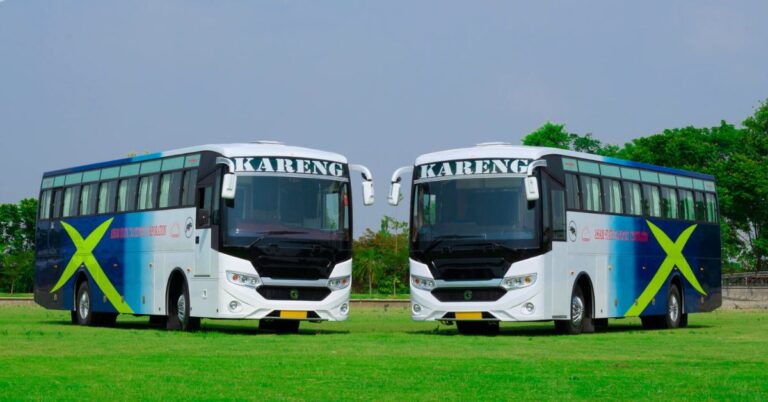AIS 153 Explained: Here’s What Bus Body Builders Need
A guide for bus body builders to navigate AIS 153, the new standard effective September 2025. It covers key certification requirements, structural changes, and safety norms, with expert insights to help manufacturers understand the updates and prepare for smooth, compliant implementation.
.webp?updatedAt=1756902256355)
From September 2025, a new rulebook will define how buses in India are built. AIS 153, the latest set of bus body building standards, will become mandatory, and every new bus will have to adhere to these amended mandates.
It marks a decisive shift toward higher safety, better design, and uniformity in bus construction.
Yet, as it often happens, many bus body builders still don’t know the full picture of what AIS 153 actually requires. In my conversations, some admitted they were confused about structural changes, fire safety norms, and even the certification process.
That’s why we decided to get to the bottom of it. We spoke with bus body builders who have already acquired the certification to understand exactly what changes the new norms demand, and how the process really works.
In this feature, I break down AIS 153 in plain terms, explaining what the regulation covers, why it matters, and how bus body builders can gear up to get certified.
Please note, I won’t go into every detail of AIS 153. Instead, I’m focusing on the latest, key changes that are essential for certification now – basically, the major updates that bus body builders need to understand and comply with.
Also, the article specifically focuses on the certification criteria for intercity buses, primarily those 12 metres and above in length, to maintain context and relevance for our readership.
For complete clarity and compliance, I strongly recommend referring to the official amendments of AIS-052: Code of Practice for Bus Body Design and Approval, published by the Automotive Research Association of India (ARAI). It contains the full set of guidelines and technical instructions in detail.
Also, I’m particularly thankful to Shivakumar V, President – Strategy & Sales and Group Chief Strategy Officer at MG Group, and Yash Sharma, Director at Damodar Group, for their invaluable support in helping bring this article to life.
MG Automotives Secures AIS 153 Certification for 13.5M Coach Range
Key Focus Areas of the Amended AIS 153
What Are the Amended AIS 153 Rules?
The amended AIS 153 is the Automotive Industry Standard formulated by the Ministry of Road Transport & Highways (MoRTH), Government of India, to bring uniformity and safety to bus and coach body fabrication.
Framed under the Central Motor Vehicle Rules (CMVR), it defines how buses in India should be designed and built, ensuring that every vehicle meets consistent standards for safety, quality, and passenger comfort, regardless of who fabricates it.
Since April 1, 2019, all OEMs (Original Equipment Manufacturers) in India have been required to follow AIS 153 for fully built buses with seating capacity above 22 passengers. Now, with the next phase kicking in from September 2025, these requirements will also extend to non-OEM body builders.
“AIS 153 marks a pivotal shift in India’s bus manufacturing landscape, ushering in a new era of safety, standardization, and global alignment. It strengthens regulatory compliance, elevates passenger protection, and drives long-overdue modernization across the industry,”
Shivakumar V, Strategy & Sales and Group Chief Strategy Officer at MG Group
Key Focus Areas of AIS 153
The amended AIS 153 rules prescribe detailed guidelines for critical areas of bus design and construction. These include:
- Noise, Vibration, and Harshness (NVH)
- Intelligent Transport System (ITS)
- Fire Safety System
- Emergency Exit
- Interior Lighting
- Engine Power to Gross Vehicle Weight
1. Noise, Vibration, and Harshness (NVH)
Passenger comfort is at the core of these regulations. AIS 153 lays down specific limits on how much noise, vibration, and sudden jolts passengers and drivers should be exposed to during a bus journey. In simple terms, the idea is to make buses quieter, smoother, and less tiring for long trips.
A. Noise Limits (Interior)
- Front-engine buses: maximum 85 dB(A)
- Rear-engine buses: maximum 80 dB(A)
- Testing is done as per IS: 12832-2010 (Reaffirmed 2016).
For context, this is about the sound of city traffic. Any louder can cause fatigue and stress.
B. Vibration Specifications
The bus structure must have a lowest natural frequency of:
- 5 Hz for vertical and bending modes
- 3 Hz for torsional modes
This ensures the structural stability of the bus body, making it rigid enough to withstand rattling and flexing during operation.
RMS Vibration Levels
Acceptable RMS vibration levels are specified differently based on the suspension type (mechanical or air suspension) and location in the bus (driver seat, passenger seat, gangway), ranging from 1 to 6 m/s².
The root mean square (rms) vibration levels at driver and passenger seats should not exceed:
| Suspension Type | Driver & Passenger Seats | Gangway |
| Front and Rear Mechanical Suspension | 3 m/s² | 6 m/s² |
| Front Air and Rear Mechanical Suspension | 2 m/s² | 4 m/s² |
| Front Mechanical and Rear Air Suspension | 1 m/s² | 2 m/s² |
It has to be noted that, if a stricter suspension setup (like all mechanical) meets the vibration limits of a more comfortable setup (like air suspension), then the test results can be used (or “extended”) for the more comfortable setup without re-testing.
C. Harshness (Transient Vibration)
AIS 153 prescribes specific quantitative limits related to harshness, focusing on vibration levels that impact passenger comfort and vehicle durability.
- Driver seat: maximum 3 m/s²
- Passenger seats: maximum 10 m/s²
- Dominant frequencies must lie outside the ranges 0.5–1 Hz, 5–7 Hz, and 18–20 Hz
These frequency bands are avoided because they coincide with the natural resonant frequencies of the human body, which can cause discomfort, motion sickness, or fatigue during travel.
Harshness depends on suspension type and location. If a harsher setup (like all mechanical) meets the limits for a softer suspension (like air suspension), the test results can be extended to the softer variants without retesting.
Vibration Measurement Protocol for Sleeper Buses
For sleeper buses, vibration levels must be carefully measured to ensure passenger comfort during rest. Accelerometers are positioned at three key locations:
- Driver’s seat
- Upper and lower berths of the middle row closest to the vehicle’s transverse and longitudinal axes
- Upper and lower berths at designated points within the sleeping area
2. Intelligent Transport System (ITS)
To improve fleet management, safety, and passenger experience, AIS 153 requires:
- LED Destination Board System for Buses
- GPS-based tracking and location systems
- Real-time passenger information displays (Interior)
- Driver behavior monitoring systems
- CCTV surveillance inside and outside with 30-day recording capability.
In addition, all ITS equipment must meet electromagnetic interference (EMI) and electromagnetic compatibility (EMC) norms standards per AIS 004 to maintain electromagnetic compatibility and avoid disruptions in functionality.

3. Fire Safety System
Fire safety is a critical component of the AIS 153 framework, aimed at minimizing fire-related risks and ensuring timely evacuation of bus occupants. Two key systems have been mandated, based on the type of bus:
Fire Detection Alarm System (FDAS) for Seater Buses:
This system must detect smoke, heat, or other fire signatures promptly and alert passengers and the driver through audible and visual alarms while activating hazard signals. The FDAS must comply with AIS-135.
Fire Detection and Suppression System (FDSS) for Sleeper Buses & School Buses:
FDSS extends detection by also including automatic suppression of fire in affected compartments, reducing the risk of fire spread and facilitating occupant evacuation.
Smoke, heat, and CO detection technologies are used, and suppression agents are strategically discharged to contain fire outbreaks.
For buses below 3.5 tonnes GVW, installation of FDAS or FDSS is optional.
4. Emergency Exits
The amended AIS 119 rules (Amendment no. 5 dated 04/2024) lay out clear requirements for emergency exits, specifying the number, type, and placement of exits based on the length of the bus.
Buses Upto 12M in Length
A minimum of four emergency exits, including:
- One emergency door
- Minimum two escape hatches (on the roof)
Buses Exceeding 12M in Length
A minimum of five emergency exits, including:
- One emergency door
- Minimum three escape hatches (on the roof)
The remaining emergency exit(s) can be in the form of windows or additional doors.
Emergency Door
The emergency door must be equipped with collapsible steps and should be operable from both inside and outside the bus. It must be located on the side opposite the service door – either at the rear face (aligned with the gangway) or in the middle section, depending on the bus layout.
In rear-engine buses, emergency doors cannot be placed on the rear face. Instead, they must be positioned on the side opposite the service door, following one of the placement options below:
- If the service door is at the front or rear half, the emergency door must be in the middle; or
- If the service door is at the front, the emergency door must be at the rear — and vice versa.
Escape Hatches
Escape hatches must be separated by at least 1 meter, measured between their nearest edges along a line parallel to the longitudinal axis of the bus.
In buses with CNG/LNG cylinders, batteries, battery cooling systems, or AC units mounted on the roof, escape hatch(es) must be positioned appropriately to avoid obstruction and ensure safe evacuation.
Please note that all emergency exits must comply with the prescribed standards for size, accessibility, and visibility.
Driver Partition Door Not Permitted
One of the key updates in the amended AIS 153 regulations is the prohibition of driver partition doors. This measure aims to ensure unrestricted passenger access to emergency exits, particularly in critical situations such as accidents or fire.
While buses may still include a driver cabin partition for operational or privacy purposes, doors or any physical barriers that could obstruct movement between the passenger area and the driver’s cabin are no longer permitted.
5. Lighting & Illumination
Buses must be equipped with sufficient lighting to ensure safe entry, exit, and movement within the passenger compartment at all times, especially during night time operations.
Driver Cabin Lighting
Cabin lighting must enable the driver to clearly identify all components of the cabin, read wall signages, and printed instructions. The luminous flux of cabin lamps should be between 30 and 150 lux, measured at 500 mm above the driver seat base.
Dashboard lighting must be discreet and must not distract the driver during night driving. The brightness should be adjustable, optionally through a rheostat or other suitable means.
Passenger Compartment Lighting
Passenger area lighting must allow clear visibility of signages, including emergency signs. Illumination should be at least 50 lux, measured at 500 mm above any seat base.
All buses, except Type I, must have at least two night lights in the passenger compartment. Interior lighting must be designed to avoid glare or reflections that could distract the driver.
Luggage Hold Lighting
Each luggage compartment must have lighting that activates when opened to ensure proper visibility during use.
Exit Lamps
Automatically light up when entry/exit doors are opened (or remain on during night if no door exists)
6. Engine Power to Gross Vehicle Weight
All buses shall have engine/electric traction motor power to gross vehicle weight ratio greater than 5 kW/ton.
.webp?updatedAt=1754997725613)
AIS 153 Type Approval Procedure for Buses
To get certified under AIS 153, bus body builders must approach an accredited testing agency such as ARAI, ICAT, or CIRT. The process begins with submitting detailed documentation, including technical specifications, design layouts, safety features, and system integrations.
After this, a representative variant of the bus must undergo physical performance and safety testing, on test tracks as required by AIS 153 and its referenced standards.
Once all technical parameters are met and the documentation is in order, the test agency issues a Type Approval Certificate for the specific bus model or variant. This certificate, along with the supporting documentation, must be submitted to regulatory authorities and is mandatory for vehicle registration.
Wrapping it Up
The new AIS 153 mandates are more than just a regulatory update – they represent a transformative step toward building buses that are safer, smarter, and more passenger-friendly. With clear standards on comfort, safety, and technology, the regulations raise the bar for how buses are designed and experienced in India.
“The new mandates are not just about compliance – it’s about elevating the entire travel experience. By making buses quieter, smoother, safer, smarter, and more inclusive, it’s setting the stage for a new generation of mobility in India,”
Yash Sharma, Director at Damodar Group.
For operators, this means investing in buses that meet rising expectations around passenger safety and comfort. For bus body builders, it’s a chance to modernize, future-proof their products, and lead confidently into India’s next chapter of public transport. While compliance may come with added costs, it also brings a clear competitive edge in quality, credibility, and readiness for a rapidly evolving mobility landscape.
This article originally appeared in the August issue of our monthly magazine, The Bus Insider.
Catch the latest Bus Industry updates, Exclusive Interviews, Bus News, and International Bus News on Coach Builders India. Download the latest issue of the The Bus Insider magazine for more insights.







